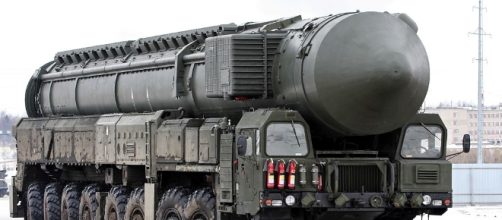Russia is now getting more serious about its nuclear deterrence. Latest reports said that the Russia’s Strategic Missile Forces are currently beefing up its nuclear arsenal, testing a new thermonuclear-armed ICBM.
According to Sputnik News International, the Russia’s Strategic Missile Forces are testing the effectiveness and accuracy of their silo-based ballistic missile. The latest test involved launching a new ballistic missile from its launching pad on the Dombarovsky missile base in the Kura testing range on the Kamchatka peninsula.
About the latest test
According to Major General Oleg Kislov, chief of the Russia’s Kapustin Yar testing range, the Russia’s Strategic Missile Forces are currently working on the development of their new silo-based missile system using the launching platform at the Dombarovsky missile base in the Orenburg region. That missile test will be using the Yasny Kura trajectory. However, the Russian general didn’t provide much detail about the latest missile test.
But some western analysts believe that the latest test could involve the newly developed heavy-class thermonuclear-armed ICBM (intercontinental ballistic missile) called Sarmat. Last year, a high-ranking military official announced that Russia had been working on a new heavyweight ICBM called Sarmat.
Some believe that the latest test is just a continuation of the previous test.
The new missile, which expected to give Russia’s Strategic Missile Forces a huge advantage over its rival America in terms of destructive power and accuracy, is slated to go on full service on 2019-2020. Additionally, the Krasnoyarsk Machine-building Plant is now getting ready for the full production of the new missile, the Sputnik News reported.
First announced in February 2014, the RS-28 Sarmat is a Russian liquid-fueled, MIRV-equipped, thermonuclear-armed ICBM. The 100-ton missile, which currently under development at the Makeyev Rocket Design Bureau, is intended to replace the aging RS-36 ballistic missile (NATO codename SS-18 Satan).
The Sarmat is reportedly equipped with up to 10 heavy nuclear warheads or up to 24 hypersonic glide vehicles. A good combination or thermonuclear warheads and massive amount of countermeasures designed to evade and defeat the more complex US missile defense system. It can travel at a speed of over Mach 20.7 or 15,480 mph and has an operational range of over 10,000 km (6,200 miles). It’s the Russia’s answer to the US Prompt Global Strike, the American’s ambitious effort to develop a global strike capability that can deliver a precision-guided conventional weapon anywhere in the world within a few minutes.
Additionally, the Sarmat is also suspected by some Western military experts to have some sort of Fractional Orbital Bombardment (FOBS) capability, a Soviet ICBM program that was developed to bypass the missile detection system used by the United States military.
The FOBS was reportedly one of the first big steps by the Russian to utilize space for the effective delivery of the nuclear weapons.
But the most frightening story about this new weapon is its ability to obliterate an area the size of France or Texas, making it the Russia’s weapon of choice in a potential nuclear exchange with the United States.
Russia also tests Islander system
In addition to the Sarmat missile test, the Russia’s Defense Ministry also announced that the latest test for the Islander tactical ballistic missile has now entered the final stage. The missile test has been conducted and completed at the Kapustin Yar testing range in southern Russia’s Astrakhan region, according to TASS Russian News Agency.
The Islander missile is a mobile short-range ballistic missile system which designed to destroy high-valued targets such as command posts, communication centers, long-range artillery and other defense systems. It can also be used to target aircraft and helicopters.
Finally, the Russian website Sputnik News also added that the Kapustin Yar is currently working on about 160 military-related projects, all for the improvement and benefits of the Russian military.


